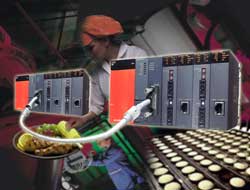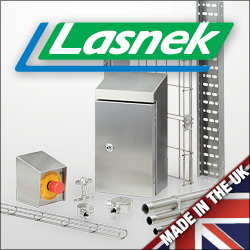
Posted to News on 15th May 2007, 20:19
The benefits of web-enabled industrial control systems
Jeremy Shinton of Mitsubishi Electric discusses the potential advantages of using web-enabled industrial control systems.

For many years businesses have improved operational performance and efficiency through automation and control. There are numerous examples of successful automation projects bringing tangible gains to businesses and, once a company has seen the benefits of automation, it is likely to consider further projects in the same vein. Eventually the situation becomes one of upgrading existing automated systems or integrating two or more systems.
Fully automated production is now fairly commonplace and businesses are looking at integrating production information and management with the commercial equivalents in terms of order-taking, production scheduling, ordering of raw materials, etc. Typically the continuous process industries are further down this line than discrete manufacturing, but the latter are catching up fast, particularly as their preferred control solution, the PLC (programmable logic controller), is becoming more powerful and able to fulfil many of the SCADA/DCS (supervisory control and data acquisition/distributed control systems) capabilities favoured in the process sector.
Available technology
The technology to connect a control system to the internet has been available for some years but, to date, its take-up has been limited, both in terms of the number of installations and capabilities accessible over the 'net'. It would seem, therefore, that the deciding factor has been one of user confidence, which is not necessarily measurable on a rational basis. For instance, it could be argued that the 9/11 terrorist attacks have held back take up of the concept; while these did not involve hacking into control systems via the internet, there was a measurable upsurge in the fear of security breaches into sensitive systems that spilled over into the industrial and commercial worlds.
Connecting automation systems to the Internet has so far been via Ethernet adaptors to a web server or PC connected to the web. However, the latest generation of PLCs, such as Mitsubishi's System Q, have fully integrated PC modules available directly within the PLC racks.
With the System Q and equivalent units rapidly gaining ground in the market, and with users now familiar with the convenience of internet and web access thanks to their home computers, there has been an upsurge of interest in web-enabled control systems.
Web-enabled field devices are already commonly used to connect to 'in-house' intranets, where 'in-house' can be company-wide or restricted to a single physical site. Significantly, access is usually restricted via password, key or biometrics to relatively few people (almost always to key personnel only), but the concept and advantages of remote access to data are being proven.
With thoughts now turning to full access over the worldwide web, potential installers are exhibiting commendable caution, saying they want access limited to certain people, to certain parts of the system, to read-only functions, etc. This is, of course, achievable and the way the developers intended that the technology should be deployed. Bespoke layers of security can be created for individual applications to prevent unauthorised access.
Advantages
Having established that web access to control systems is possible, let us look at potential uses and advantages.
A typical use of the web could be to create a secure and direct VPN connection to monitor load and recipes, or even to modify programs within certain parameters.
Remote PLCs can collect and process raw data from local operations into business, maintenance or exception reports and email these to one or more central locations. Such PLCs can even use web-based messaging services to text maintenance details to an engineer.
An obvious use is plant and machinery maintenance. Many plants include inaccessible areas, cover a large physical area, or include remote outstations, where actual sight of the machinery is not practical. Instead, sensors are used to monitor the machinery and send signals back to a central control room. With maintenance engineers being readily mobile, it makes sense to have this data available on an intranet or the internet so that assessments can be made promptly, wherever the engineer happens to be. This is attractive for simple maintenance tasks; for more involved decisions - such as those that would have a serious impact upon production, require a notable financial outlay, could involve safety considerations, or have commercial ramifications - the advantages are that all necessary senior personnel can view data and therefore make informed decisions.
Business issues
If the production control system is integrated with commercial systems, it becomes possible to optimise production schedules in real time, relating to order input and raw materials availability. This would simultaneously improve machine utilisation, supply management and overall production efficiency. It would also improve customer service in that clients could be kept fully up-to-date with the progress of their order.
Financial control of an enterprise can be enhanced because work in progress can be analysed in real time. This will highlight bottlenecks and where money is being unnecessarily tied up.
In conclusion, it seems likely that web access to production and/or enterprise control systems will become increasing common over the next few years. The technology to do this is already available and users are now confident that issues such as security and integrity can be guaranteed. Five years from now we will probably wonder why we were so reluctant to connect to the web.


















